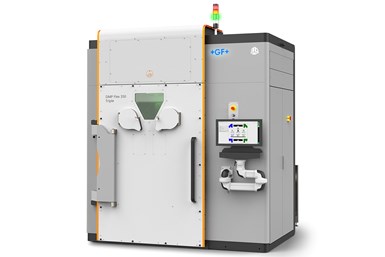3D Systems’ DMP Flex 350 Triple Offers Efficient, Adaptable Solution for Metal Part Production
The latest configuration of the DMP Flex 350 platform adds a third laser and larger build area to deliver higher productivity and large, seamless parts.
The system is designed as an efficient, adaptable solution for metal part production. Source: 3D Systems
3D Systems’ DMP Flex 350 Triple is the latest configuration for its DMP Flex 350 platform. This compact, three-laser system includes the company’s vacuum chamber design and extends the signature Removable Print Module (RPM) concept by supporting two distinct RPM modules with different build volumes.
The company is making a wide range of materials available for use with this printer. The DMP Flex 350 Triple is engineered to enable the efficient production of high-quality end-use parts in a breadth of industries, including automotive, semiconductor, consumer goods, space, energy and medical devices.
Larger Build Capacity, Same Footprint
The system is designed as an efficient, adaptable solution for metal part production. The DMP Flex 350 Triple features the availability of a new RPM with a larger build of 350 × 350 × 350 mm and can also accommodate the standard RPM with a build volume of 275 × 275 × 420 mm. The company says this makes the DMP Flex 350 Triple the most compact system that supports a 350 × 350 × 350 mm build area. It also makes it well suited for cost-effectively processing a variety of parts, including instance impellers and cooling plates. The RPMs can also be swapped for increased application flexibility.
Seamless 3-Laser Load-Balanced Print Capability
The DMP Flex 350 Triple laser offers optimal multilaser load balancing and seamless surface quality scan strategies. This results in no seams or changes in roughness in zones where multiple lasers work together.
Eight Materials for a Wide Range of Applications
It is capable of processing a wide range of aluminum alloys, including traditional cast alloys (AlSi10Mg, AlSi7Mg0.6), high-strength aluminum alloys (A6061-RAM2) and high-conductivity aluminum (CP1). This variety makes the system useful for thermal management as well as lightweight structural applications. Additionally, nickel-based alloys such as Ni718, Ni625 and HX are available for high-temperature, corrosion-resistant applications. Finally, 316L stainless steel is available which is commonly used in the petrochemical, food and pharmaceutical industries.
The new RPM with the 350 × 350 × 350-mm build box is planned for general availability in July 2024.
Related Content
-
Video: 5" Diameter Navy Artillery Rounds Made Through Robot Directed Energy Deposition (DED) Instead of Forging
Big Metal Additive conceives additive manufacturing production factory making hundreds of Navy projectile housings per day.
-
Postprocessing Steps and Costs for Metal 3D Printing
When your metal part is done 3D printing, you just pull it out of the machine and start using it, right? Not exactly.
-
Possibilities From Electroplating 3D Printed Plastic Parts
Adding layers of nickel or copper to 3D printed polymer can impart desired properties such as electrical conductivity, EMI shielding, abrasion resistance and improved strength — approaching and even exceeding 3D printed metal, according to RePliForm.















